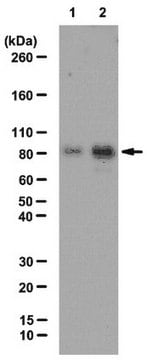ABT1378
Anti-Acetyl Cortactin (Lys309)
from rabbit
Sinonimo/i:
Amplaxin, Oncogene EMS1, Src substrate cortactin
About This Item
Prodotti consigliati
Origine biologica
rabbit
Livello qualitativo
Forma dell’anticorpo
affinity isolated antibody
Tipo di anticorpo
primary antibodies
Clone
polyclonal
Reattività contro le specie
monkey
Reattività contro le specie (prevista in base all’omologia)
human (based on 100% sequence homology)
tecniche
immunofluorescence: suitable
western blot: suitable
N° accesso NCBI
N° accesso UniProt
Condizioni di spedizione
ambient
modifica post-traduzionali bersaglio
acetylation (Lys309)
Informazioni sul gene
human ... CTTN(2017)
Descrizione generale
Specificità
Immunogeno
Applicazioni
Cell Structure
Western Blotting Analysis: A representative lot detected Acetyl Cortactin (Lys309) in transfected COS-7 cells (Ito, A., et. al. (2015). Sci Signal. 8(404):ra120).
Immunofluorescence Analysis: A representative lot detected Acetyl Cortactin (Lys309) in COS-7 cells treated with or without Trichostatin and Nicotinamide (Ito, A., et. al. (2015). Sci Signal. 8(404):ra120).
Qualità
Western Blotting Analysis: A 1:1,000 dilution of this antibody detected Src substrate cortactin in lysates from COS-7 cells stimulated with Trichostatin (1 mM) and Nicotinamide (5 mM).
Descrizione del bersaglio
Stato fisico
Stoccaggio e stabilità
Handling Recommendations: Upon receipt and prior to removing the cap, centrifuge the vial and gently mix the solution. Aliquot into microcentrifuge tubes and store at -20°C. Avoid repeated freeze/thaw cycles, which may damage IgG and affect product performance.
Altre note
Esclusione di responsabilità
Non trovi il prodotto giusto?
Prova il nostro Motore di ricerca dei prodotti.
Codice della classe di stoccaggio
10 - Combustible liquids
Classe di pericolosità dell'acqua (WGK)
WGK 2
Certificati d'analisi (COA)
Cerca il Certificati d'analisi (COA) digitando il numero di lotto/batch corrispondente. I numeri di lotto o di batch sono stampati sull'etichetta dei prodotti dopo la parola ‘Lotto’ o ‘Batch’.
Possiedi già questo prodotto?
I documenti relativi ai prodotti acquistati recentemente sono disponibili nell’Archivio dei documenti.
Active Filters
Il team dei nostri ricercatori vanta grande esperienza in tutte le aree della ricerca quali Life Science, scienza dei materiali, sintesi chimica, cromatografia, discipline analitiche, ecc..
Contatta l'Assistenza Tecnica.







